
The Interrupted History Of Running Water
Today we take running water for granted and shudder at the thought of being catapulted back in time to the days when people threw their waste into the rivers and streets. Let’s take a quick look at the history of running water.
The earliest water pipes were found amongst the ruins of a palace in the Indian Indus River Valley. The copper pipes there are believed to date back to 4000 – 3000 BC and, in Egypt, clay pipes from 2500 BC are thought to have carried water to palace bathrooms as well as to crop fields. In China, bamboo pipes which date back to 500 BC were used to transport natural gas, whilst we also know that the ancient Greeks used underground clay pipes to provide a water supply to their cities. But it is the plumbing systems of the Roman empire which are perhaps most well-known to us. The growing populations that developed in the cities throughout the empire demanded a clean supply and the Roman’s network of aqueducts, sewers and bronze piping helped to meet this need. By c.52 AD, the network feeding into Rome was around 220 miles long.
Regression
Despite the construction of these seemingly advanced ancient plumbing networks centuries earlier, we know that by the Middle Ages, Europe was rife with disease and lacking any kind of sanitation system. The fall of the Roman empire had seen its water network destroyed or fall into disrepair, and as many people moved away from cities in the time after, the demand for a sophisticated water and waste management system diminished. However, unlike had been the case in ancient times, when the population of key towns and cities such as London did grow again over time, sanitation failed to keep up. Unhygienic practices then became commonplace, and as a result, so too did sickness and diseases such as dysentery and typhoid fever. The Plague of the mid-1300s claimed the lives of around one third of the population of Europe and, in London, the Great Plague of 1665 killed 100,000 citizens. It was only following this final outbreak of bubonic plague that people began to take the concept of sanitation more seriously.
The Development of Water Systems In London
Public wells and fountains were installed, from which people could draw clean water, and the Renaissance period saw the renewed development of household pipes and toilets, but it wasn’t until the invention of a centralised water supply system that things really begin to change for the better in London. Sir Hugh Myddleton, an entrepreneur and self-taught engineer, constructed a 30-mile-long canal from Hertfordshire to Islington together and a network of wooden pipes, made from the bored trunks of whole elm trees, was laid, providing water to many homes in London. For a subscription fee, wealthy homeowners had the luxury of a system of lead pipes which could channel water to a cistern directly into their homes. New water companies sprang up in the capital, and by the early 1700s most homes in London’s West End had a supply of running water. These systems spread across the United Kingdom, Europe, and North America, and by the early 1800s most homes were built with a household plumbing system. Iron pipes soon began to replace wood and lead and the new reliable water supply gave rise to the invention of indoor toilets and showers. In 1858, the first sewage system was designed by London-based engineer Joseph Bazalgette in response to an 1847 report proving that cholera was caused by drinking contaminated water.
What If?
From there, water, sanitation and sewer systems continued to develop and, to help manage this and ensure that clean water would be provided to all (not just the wealthy), legislation was drawn up and water companies were nationalised. But despite these great accomplishments in sanitation, one cannot help but wonder how technologically advanced we might be now had Western civilisation not wasted centuries developing ideas that had already been invented by our ancient ancestors.